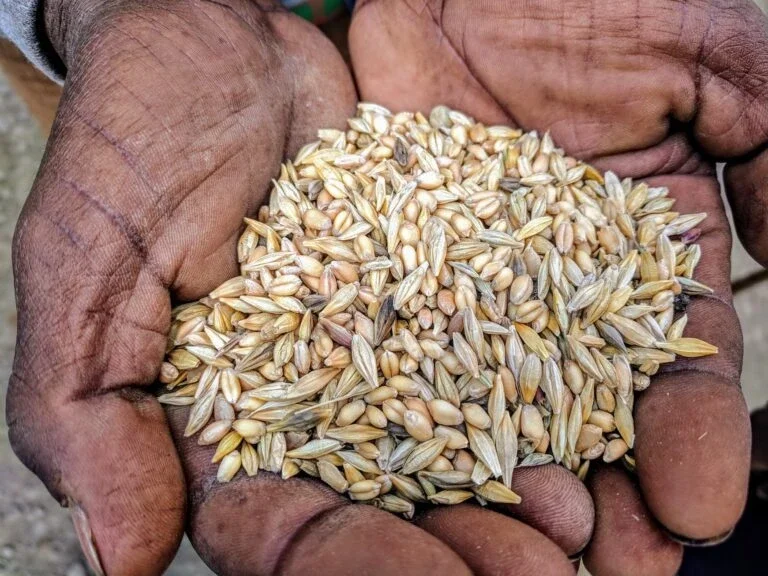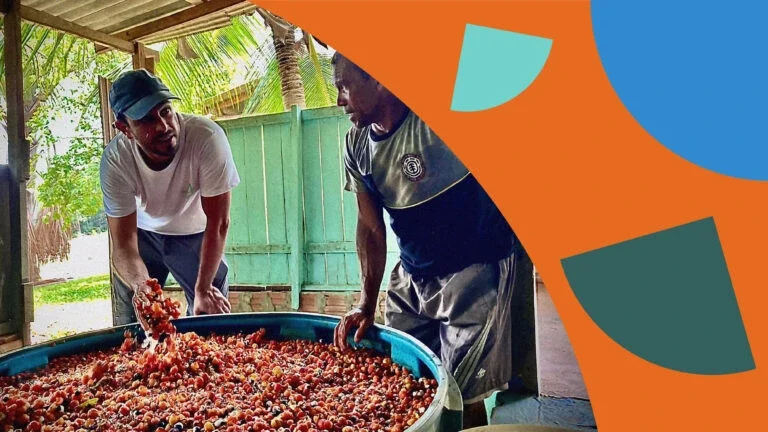What if every public school and hospital in the United States and around the world consistently offered nutritious food grown sustainably by area farmers? If that seems like an obvious strategy, it is unfortunately all too rare. For decades, our food system has obscured its true costs: environmental degradation, poor health outcomes, and an economic squeeze on small- and mid-sized farmers. Public dollars are mainly directed to the cheapest, least nutritional options, reinforcing a system that values short-term savings over long-term resilience and nourishment. The Rockefeller Foundation is working to upend that dynamic and to move from low-cost foods to best-value foods that nourish people, support farmers, and sustain the planet.
As we dug into the data, the immense scale of the U.S. industrial food system’s costs came into sharp focus: soaring rates of diet-related diabetes, air and water pollution from industrial-scale farming, and hidden production and processing costs that drive up retail prices and spur economic inequities. Meanwhile, regional, values-driven food systems remain under-resourced and lack the strong policy and market support necessary to transform the current food system.
Over the past five years, through our Good Food Procurement work, The Rockefeller Foundation has partnered with community-based organizations, nonprofits, cities, and regional coalitions across the United States to connect public food purchasing with diet, equity, and climate goals. Together, we’ve built models that reimagine how public institutions can help create a more just and sustainable food system. Though this work has so far centered on the United States, its implications are global. Whether in high- or low-income countries, the core conditions for sustainable food procurement are strikingly similar: farmers need infrastructure, stability, and a pathway into public markets; lawmakers need local data to create meaningful policies and ensure impactful implementation; and everyone needs a system that delivers social, environmental, and economic value.
Below are three key insights from our U.S. work:
1. Invest in Farmers Upfront
If we want farmers to use regenerative and sustainable practices to reliably supply public institutions, we need to address the economic realities they face. Unlike large agribusinesses, small- and mid-sized farmers often operate on thin profit margins, fluctuating seasonal incomes, and limited access to credit, labor, and infrastructure. For these farmers, transitioning to environmentally sound practices like regenerative or sustainable agriculture are risky and can be prohibitively expensive. With a focus on ecological and social outcomes, regenerative farming is applied through practices that vary by place and include cover cropping to maintain soil integrity, rotational grazing to keep pastures healthy, and integrated pest management to minimize risks to people and planet, all of which comes at a price. Doing this while also scaling to meet the demand of public institutions is a massive technical and financial challenge.
It’s why increasing demand alone isn’t enough to support producers in accessing it. Without guaranteed markets, adequate financing, and stability, most farmers can’t afford to make the long-term investments required to grow, adapt, or certify their operations for institutional buyers like schools and hospitals. To address this, The Rockefeller Foundation supports models that de-risk the transition for producers ― pairing institutional procurement with direct investments in regenerative farmers.
For example, in Georgia, we supported and The Common Market Georgia and the ACRE Collective (ACRE), through a grant to The Common Market Philadelphia Inc., to pilot a groundbreaking approach: Partnering forward commitments ― where institutions like schools and hospitals committed to purchasing certain volumes of food in advance ― with financial and technical assistance so farmers received pre-season payments, grants for equipment or infrastructure, and tailored technical assistance to help them meet volume, food safety, and specification requirements.
The results were transformative:
- Farmers gained market predictability and improved profitability, allowing them to plan planting schedules, invest in labor or equipment, and avoid unnecessary waste.
- Institutions secured a steady supply of fresh, local, climate-aligned foods, enabling them to meet sustainability and nutrition targets with greater confidence.
- The regional food system became more resilient, as the investment in farmers had ripple effects across supply chains ― from increased yields preserved in cold storage to improved logistics.
The ACRE Collective’s new report highlights the Power of Institutional Forward Commitments and how, combined with access to land, capital, and markets, regenerative procurement can boost rural investment while helping the climate.
Lesson: When farmers have guaranteed demand and shared risk, they are more likely to serve public institutions and invest in better practices.
2. Increase Access to Regional Infrastructure and Coordination
Next, we need to focus on what happens between the field and the cafeteria. That means investing in the intermediaries, value-chain infrastructure, and coordination mechanisms and relationships that connect small- and mid-sized food producers to institutional markets.
Without trusted intermediaries and reliable value-chain infrastructure, the benefits of sustainable and values-based food procurement policies won’t matter. Even farmers who grow nutrient-dense food, in ways that restore ecosystems and sustain livelihood, still need access to the logistics and infrastructure that connect them to schools, hospitals, and other institutions. They need:
- Food hubs and aggregation centers to combine products and reach markets at scale.
- Cold storage and processing facilities to preserve and package food to institutional specifications.
- Reliable transportation systems and partners to move food from rural areas to urban institutions.
- Technical assistance to navigate procurement systems and contracts, meet food safety standards, and secure certifications.
These are the foundations of a functioning regional food system. In the United States, however, supply chain infrastructure and support remain drastically underfunded. Public investment has historically favored large-scale industrial agriculture or emergency feeding programs, leaving little support for the infrastructure that enables small- and mid-sized farmers to access institutional markets. Recent USDA initiatives, such as the Regional Food Business Centers, Local Food for Schools, and Local Food Purchasing Assistance programs, made important strides, but as temporary programs, which have now ceased or been terminated, they were ultimately insufficient to meet the needs of farmers to supply the growing demand for local, sustainably sourced food. Many communities ― especially those with marginalized, small, and rural farmers ― are forced to rely on patchwork systems with limited support.
In addition to funding, the “soft infrastructure” of coordination and relationship-building is crucial. Coalitions strengthen regional governance so they can sustain systemic changes and cultural shifts over the long term. The Rockefeller Foundation has invested in coalitions that bring together farmers, producers, distributors, buyers, community organizations, and policymakers around shared goals and the co-development of programs that meet local priorities. Intermediaries play a critical role in this ecosystem, serving as trusted coordinators who support institutions in building and maintaining relationships with farmers, navigating procurement processes, and translating shared values into actionable purchasing. These networks and actors foster trust and create the conditions to deliver the most nutritional, economic, environmental, and equitable benefits.
In Atlanta, the ACRE Collective is bridging the gap between farmers and the city’s growing institutional demand by helping farmers meet wholesale standards and navigate food-safety requirements. The group also provides critical aggregation and distribution infrastructure, strengthens connectivity across the regional food system, coordinates partnerships and strengthens leadership and buy-in within institutions, and supports local health, equity, and climate goals. ACRE’s work on both regenerative farming practices and market access shows that when hard and soft infrastructure is in place, it’s possible to create a better food system.
Lesson: Prioritize hard and soft value-chain infrastructure ― the people, places, and processes that connect local supply to public demand.
3. Support Coalitions that Connect Policy Implementation to Local Context
Many cities are adopting food policies to advance regenerative agriculture, sustainability, and equity goals, but decision-makers often lack complete information and need informed resources to understand local priorities, identify opportunities in the regional foodshed, and consider trade-offs or unintended impacts that emerge during implementation. Sustainable procurement policies do not exist in a vacuum: mandates for regenerative agriculture and access to the supply chain falter without sound conditions. Multi-sector coalitions can help cities navigate these complexities by providing evidence-based research to ensure policy decisions are grounded in their unique contexts, validated by local stakeholders, and aligned to needs and opportunities. This research can equip governments with the clarity and confidence to design programs that succeed and endure.
The Rockefeller Foundation supports this type of coalition-informed work through participatory research that brings together city officials, academics, and food system stakeholders. In New York City, for example, the City Food Policy Project — led by Colorado State University and Cornell University in partnership with the Mayor’s Office of Food Policy — tests and de-risks policies and sourcing strategies to expand local, sustainable food procurement, while modeling how changes affect cost, capacity, and emissions and how actors in the food system might respond. Critically, it engages regional stakeholders outside the city and across the supply chain — farmers, processors, distributors, and city officials — to validate assumptions, refine designs, and ensure that policies strengthen regional relationships and buy-in while advancing municipal climate, equity, and regional resilience goals. By engaging regional partners, NYC gains the insight needed to design policies and Requests for Proposals that farmers and food businesses can realistically meet, while tailoring procurement to local capacity and market dynamics ensures public dollars drive desired outcomes.
In Chicago, the Chicago Food Policy Action Council (CFPAC) provides another strong example of coalition power. CFPAC has built a broad, community-rooted network that created a shared vision and strategy for a more equitable and sustainable food system. By embedding staff in city government, offering technical assistance directly to institutions, and working with city, county, and state leaders, CFPAC helps align resources and policy decisions with community priorities. This coalition-led approach not only informs procurement reform but also builds durable governance structures that center equity and local resilience.
Coalitions are also imperative in both informing research and ensuring implementation. By grounding research in local priorities and validating assumptions with diverse stakeholders, coalitions make policy design more accurate and context-specific. At the same time, their continued engagement during implementation builds the trust, capacity, and alignment needed for cities and institutions to follow through. Together, this dual role of informing research and supporting implementation ensures that values-based procurement policies are not only well-designed but also effectively delivered.
Lesson: Sustainable food procurement policy is most effective when it’s co-designed with relevant regional partners and tailored to local realities.
These three lessons ― investing in farmers, strengthening infrastructure, and supporting broad stakeholder engagement that de-risk policy actions and implementation ― underscore the promise of regenerative food procurement for public institutions. These lessons have informed the ACRE Collective’s work, New York City’s food policies, and the development of The Rockefeller Foundation’s new $100 million Big Bet to Regenerative School Meals, which is helping national and local governments around the world provide nutritious and increasingly regeneratively sourced school meals to 100 million children. Promoting regenerative agriculture and helping farmers connect to public institutions in the United States and around the world makes sense for farmers, the environment, and society ― and will pave the way for a more sustainable and nourishing future.



